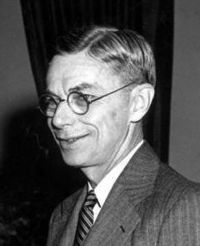James Bryant Conant
James Bryant Conant was an American chemist, a transformative President of Harvard University, and the first U.S. Ambassador to West Germany. Conant obtained a PhD in Chemistry from Harvard in 1916. During World War I he served in the U.S. Army, working on the development of poison gases. He became an assistant professor of chemistry at Harvard in 1919, and the Sheldon Emery Professor of Organic Chemistry in 1929. He researched the physical structures of natural products, particularly chlorophyll, and he was one of the first to explore the sometimes complex relationship between chemical equilibrium and the reaction rate of chemical processes. He studied the biochemistry of oxyhemoglobin providing insight into the disease methemoglobinemia, helped to explain the structure of chlorophyll, and contributed important insights that underlie modern theories of acidbase chemistry.
James Bryant Conant was born in Dorchester, Massachusetts, on March 26, 1893, the third child and only son of James Scott Conant, a photoengraver, and his wife Jennett Orr ne Bryant. Conant was one ofboys who passed the competitive admission exam for the Roxbury Latin School in West Roxbury in 1904. He graduated near the top of his class in 1910. Encouraged by his science teacher, Newton H. Black, in September of that year he entered Harvard College, where he studied physical chemistry under Theodore W. Richards and organic chemistry under Elmer P. Kohler. He was also an editor of The Harvard Crimson. He joined the Signet Society and Delta Upsilon, and was initiated as a brother of the Omicron Chapter of Alpha Chi Sigma in 1912. He graduated Phi Beta Kappa with his Bachelor of Arts in June 1913. He then went to work on his doctorate, which was an unusual double dissertation. The first part, supervised by Richards, concerned The Electrochemical Behavior of Liquid Sodium Amalgams the
Source: Wikipedia

